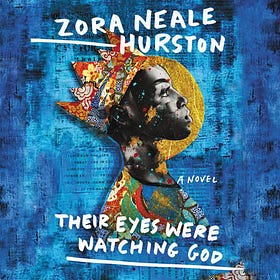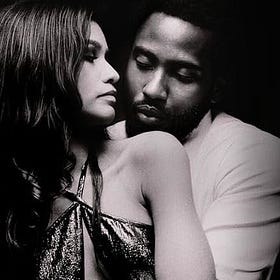Write Stories That Truly Haunt
How to use metaphor and symbolism the right way from Zora Neale Hurston's "Their Eyes Were Watching God"

Some stories stick with us. Some get inside our blood and become a part of us. One such story I’ve talked about before and I’ll likely talk about many times more: Zora Neale Hurston’s Their Eyes Were Watching God. It’s one of the only books I’ve ever read that has become a part of me. I couldn’t put it down and wanted to read it again as soon as I was done. The novel is not just a story but an experience–full of moments that touched, infuriated, and blew my mind.
But why? What is it about this story that gets under my skin, and how can YOU get that same result with your stories?
Hurston used a piece of the writer’s toolbox which we all should learn from: metaphors, but not just simple ones. She mastered the art of using metaphors that are super contextual and rooted in the story’s setting. I mean, the queen herself turned a simple pear tree into a symbol of the protagonist, Janie’s, desire, love, freedom, and self discovery in a way that hits home for every reader.
So how can you use metaphors that capture your reader’s imagination and touch their hearts? Let’s get into it.
What are Metaphors?
Metaphors are as close to magic as humans can get. Stephen King once said writing is the ability to transmit an image from one person’s mind to another–telepathy itself. Metaphors work the same way. They break down familiar concepts to help us turn abstract ideas into something concrete and universal: like a shortcut for a writer to help them connect with the reader when concepts are too big or too expansive to break down easily.
Let’s see that technique in action:
The Pear Tree
The pear tree we talked about earlier is Janie’s idealized version of love:
“It was a tree in bloom, with bees busy among the flowers. She saw a dust-bearing bee sink into the sanctity of the bloom; the thousand sister-calyxes arch to meet the love embrace.”
This image is Janie’s idea of love where both parties nourish and sustain each other. A harmonious and mutually beneficial connection. An idealistic view shaped by her 16-year-old innocence and naivety.
If we go deeper, the metaphor has a subtle foreshadowing. Like all trees, the pear tree will wither and die, just as Janie’s view of love matures and evolves as she faces life’s challenges throughout the story.
The Horizon
Zora Neale Hurston uses the horizon as a metaphor to tie in the themes of freedom, dreams, and self-discovery throughout Janie’s journey. In the first chapter, the horizon represents the universal longing for something more—dreams that seem just out of reach. Hurston writes:
“Ships at a distance have every man’s wish on board.”
This sentence immediately ties the horizon to human desire. The imagery shows the gap between aspiration and reality. The tone is set for Janie’s personal journey to find a life that is true to her dreams.
As the story goes on, the horizon shifts to reflect Janie’s growing understanding of love and life. Early in her journey, the pear tree metaphor captures her youthful ideas of love and the horizon represents promise and possibility. But as she becomes disillusioned with her marriages to Logan Killicks and Joe Starks, the horizon seems further away. More like a dream that’s out of reach. By the time Janie meets her love interest Tea Cake, the horizon is a shared space of possibility—one that’s more grounded in mutual respect and joy but not without its own challenges. Through this evolution, Hurston uses the horizon to mirror Janie’s inner growth as her idea of fulfillment matures with experience.
By the novel’s end, the horizon has a whole new meaning. After Janie losing Tea Cake and returning to Eatonville, her hometown and the novel’s central setting, Hurston writes of her protagonist: “She pulled in her horizon like a great fish net. So much of life in its meshes!” In this moment, the horizon is no longer something out there and unattainable. It’s the fullness of Janie’s lived life—her love, loss and resilience. Hurston ties the horizon to the larger theme of self-discovery. She demonstrates that true fulfillment isn’t found in some external dream, but in the wisdom that comes from living life’s complexities.
How to Use Metaphors Like Hurston
Anchor Your Theme
First, figure out what your story is really about. I don’t mean just the plot. What is the emotional core? Is your tale about longing like Janie’s search for love? Resilience? Redemption? Whatever the theme is, your metaphor should reflect that core.
In Hurston’s story, the pear tree is the perfect symbol for Janie’s romantic ideals. It’s natural, harmonious and beautiful—everything she wants love to be. Your metaphor should do the same heavy lifting for your story. Is your protagonist trying to rebuild their life? Maybe your metaphor is a broken vase glued back together. Is it about navigating chaos? Maybe feature a storm at sea. Pick something tangible that embodies your story’s heart.
Let Your Metaphors Evolve
Metaphors aren’t static. They should grow and change with your character. Hurston transforms the hurricane in Their Eyes Were Watching God from being just a storm into a metaphor for chaos and destruction. The hurricane forces Janie to confront her own strength and resilience. We are shown how far she’s come since the pear tree days.
Your metaphors can—and should—do the same. Let them reflect your character’s journey. If your metaphor is a stone bridge at the beginning, maybe by the climax it’s a crumbling bridge that barely holds together. Or if it’s a seed, maybe it grows into a tree, (because, as overused as they may be, trees are storytelling gold).
Be Subtle
Here’s where writers trip up: they try to explain their metaphors. Hurston doesn’t stand over Janie in the pear tree scene and say, “This is her dream for love!” Instead, she lets us feel as much through Janie’s gaze,the language, and the moment. Subtlety gives your readers the joy of discovery. Trust me, they’ll thank you for that space.
Think of your metaphor like a quiet wingman—it’s there to help your story shine, not steal the show. So if you find yourself wanting to add, “And by this I mean…” just don’t. Let your metaphor breathe. Trust your readers to get what you are saying.
Don’t Fall Into the Trap
Not all metaphors are winners. Some are clunky, some are confusing, and some—worst of all—are over-emphasized. If your metaphor needs a user manual, it’s too obscure. If you’re jamming one into every other sentence, your readers will feel like they’re wading through syrupy language. Be intentional. Stick to one or two solid metaphors that really carry the weight of your story.
Your Mission (Should You Choose to Accept)
Let’s get practical. Mastering metaphors like Hurston takes time, but here’s a few steps to get you started:
Brainstorm Your Metaphor. Start with your story’s core emotion. What’s your story really about? Write that down. Then, come up with five objects or images that represent that feeling. If your story’s about resilience, think of trees bending in the wind, a river carving through stone, or even a phoenix rising from the ashes. Keep it simple yet meaningful.
Practice Subtlety. Once you’ve chosen your metaphor, practice weaving it into your story. Here’s the trick: show, don’t tell. Instead of saying, “She felt free,” show her standing at the edge of a windswept field, the horizon stretching out before her. That’s freedom we can feel.
Revise, Revise, Revise. Metaphors rarely come out perfect the first time. When you revise, pay attention to how the metaphor interacts with the rest of the story. Is it clear? Is it subtle? Does it evolve with your character? Small changes can make a big difference.
Bringing it all Together
Metaphors aren’t just fancy language—they’re the foundation of emotional storytelling. They take abstract ideas and make them concrete so your story becomes something we can feel in our bones. Hurston’s use of the pear tree, the horizon, and the hurricane didn’t just describe Janie’s journey. They made us live the journey with her.
So what’s the one take away from Hurston’s genius? Your metaphors should reflect the core of your story. Let them breathe, let them whisper, and trust your readers to get them. The best metaphors don’t just make stories memorable, they make them timeless.
So go ahead, pull in your horizon and start writing metaphors that will have your readers thinking, feeling and dreaming for centuries.
Need to know if you’re using metaphors and symbolism well in your story? OBA Media’s writer/editors and story coaches are here for you! We’ve got a few spots for a FREE consult left—we’ll help you get your story unstuck so you can write without fear.
Learn about some related storytelling techniques:
Does Your Voice Actually Matter?
How culture is its own character in a story and why YOUR authentic voice matters, even if it doesn't feel "mainstream enough" to sell.
Why Your Story Feels Flat
How to use subtext and contrast to create emotional immersion in your story with examples from the film "Malcolm & Marie."




